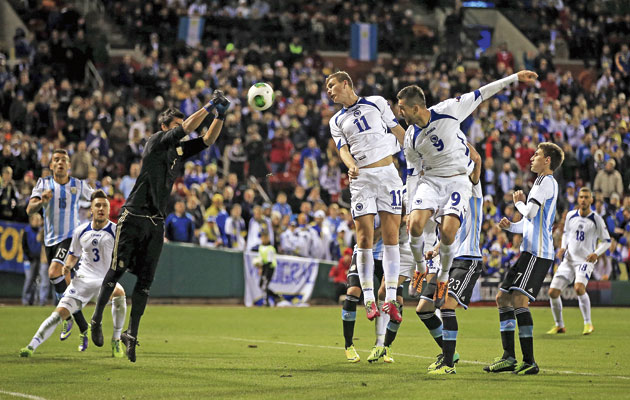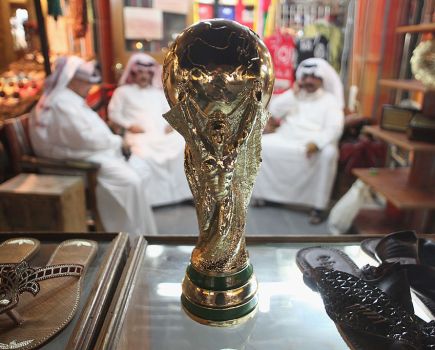Argentina
Argentina might be built around Lionel Messi, but it is not the Catalan version, where Barcelona press from the front and seek to dominate possession. Alejandro Sabella’s side is designed to play more on the counter-attack from deep than Barca.
Plan A is simple: maximise the quality, pace and sharp finishing offered by the potent front three of Messi, Gonzalo Higuain and Sergio Aguero. In the preferred 4-3-3 formation, Messi is free to move wide and deep while Aguero’s interlinking with Messi is complimented by Higuain’s positioning as the most advanced reference point.
Angel Di Maria’s dynamism in taking attacks forward, while also diligently tracking back on the left flank, is crucial to the team’s overall balance.
The midfield requires a player with vision and range in his passing, making Fernando Gago central to the functionality of the side. Alongside Javier Mascherano, Gago is vital to help launch those attacks and statistically, the Boca Juniors midfielder is the player who passes the most to Messi.
Gago, however, has had a knee injury that will keep him out of action until the tournament starts. Esteban Cambiasso’s name has been mentioned, but Sabella may opt for Ever Banega or Lucas Biglia for the group games and wait for Gago to recover.
Ventures forward by the full-backs Pablo Zabaleta (on the right) and Marcos Rojo (on the left, who plays as a centre-back for his club) are sometimes limited as Sabella aims to provide a solid base from which to allow his forward line to inflict damage.
Other options include Maxi Rodriguez, who provides movement and width in midfield, while Rodrigo Palacio and Ezequiel Lavezzi have similar characteristics in attack. Midfielders Jose Sosa and Biglia have both been favoured when removing one of the forwards in order to add presence in the centre of the side.
Plan B?
Argentina employed a five-man defence for games at altitude during the qualifiers, and this could be used to shore up the defence in a 5-3-2 formation.
Such a system would operate either with an extra centre-back or the introduction of another midfielder, such as Biglia to allow Mascherano to play a deeper role, closer to the one he fulfils for Barcelona.
Either Higuain or Aguero would give way for the extra midfielder.
Bosnia
During qualifying, Susic packed his side with attacking, creative players, even against solid defensive teams such as Greece. However, his preferred set-up, with a midfield diamond, has started to be exposed.
He publicly admits that he has only 12 or 13 good players and that the alternatives are not on the same level, so his problem is trying to squeeze those players in to a starting XI. As a result, there is a lot of improvisation and unbalance in the team.
Bosnia are dangerous when in possession, but their big problem comes when they have to defend. The lack of a quality holding midfielder is most noticeable against top-notch, mobile opposition. The central defenders are slow and need support in the middle, where Haris Medunjanin and Sejad Salihovic compete for a place.
A number of options open up when Bosnia are attacking. Zvjezdan Misimovic and Miralem Pjanic are the creative duo in midfield and they provide the service for Edin Dzeko and Vedad Ibisevic.
The emergence of full-back Sead Kolasinac has given more balance to the left side, allowing Senad Lulic to became a regular on the left flank. On the right, Mensur Mujdza is an attacking full-back.
Pjanic, Salihovic and Misimovic are all considered to be free-kick specialists.
Susic makes no bones about his attacking approach. Last year, he told World Soccer: “I do not have any choice! Look at my team. We have two top strikers in Dzeko and Ibisevic, a couple of very creative but also attack-minded midfielders like Misimovic and Pjanic, then Lulic, Salihovic, Mujdza.
“We have to play like we do now. It may sound tactically immature, I am fully aware of that, but I just think that it would be wrong to play differently. We know that we expose ourselves too much and that there is a huge risk in the way we play – using one defensive midfielder and opening up huge space for an opponent – but it would be unfair to the fans.
“We know that it can cost us, but that is the price we are willing to pay. In the end, we play to score more goals than the opposition – and it has paid off so far.”
Plan B?
Although Susic is considered stubborn, he has experimented with different systems and there is a chance that he could decide to go 4-2-3-1, with Ibisevic dropping to the bench and Medunjanin joining Salihovic.








